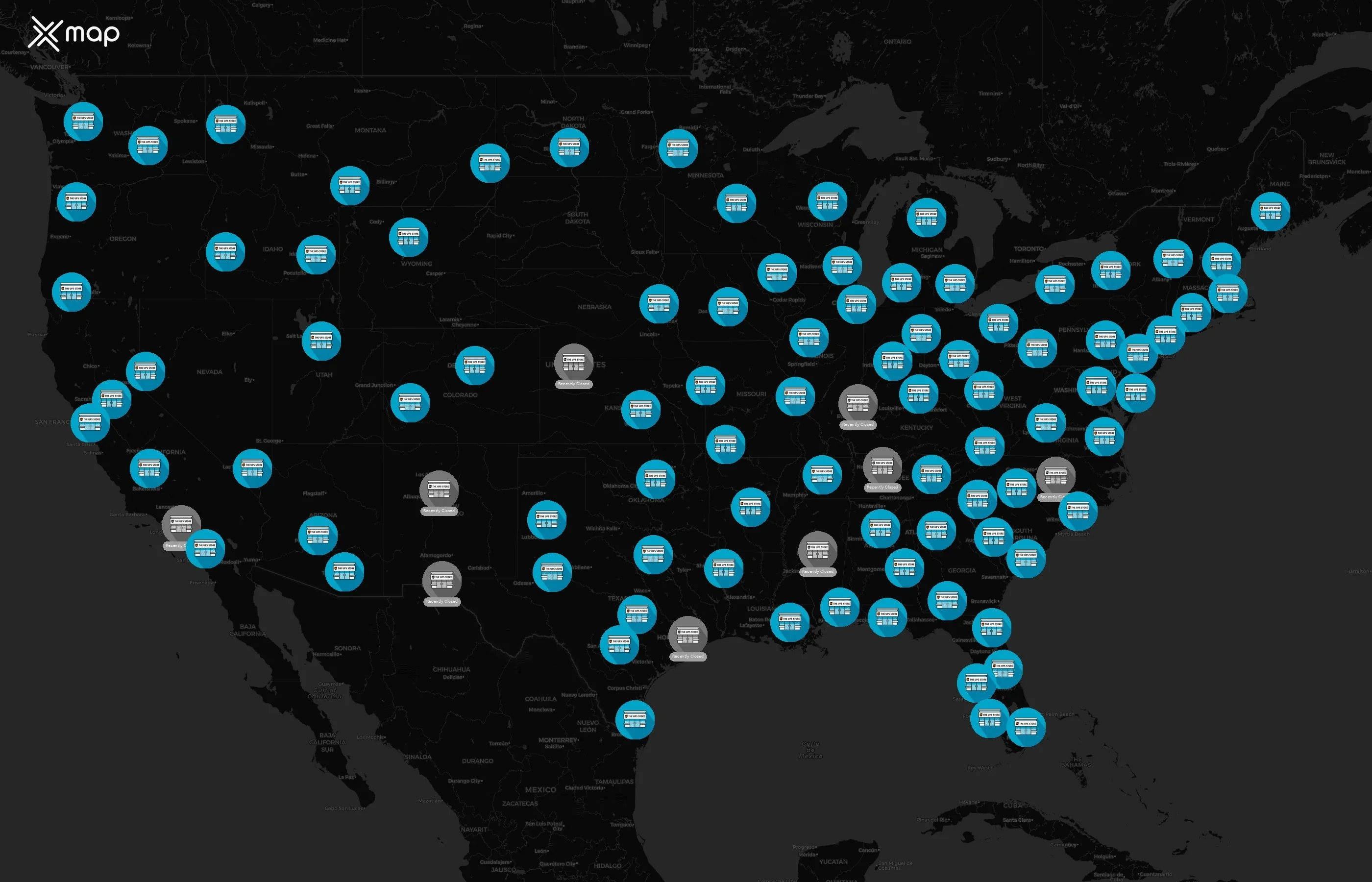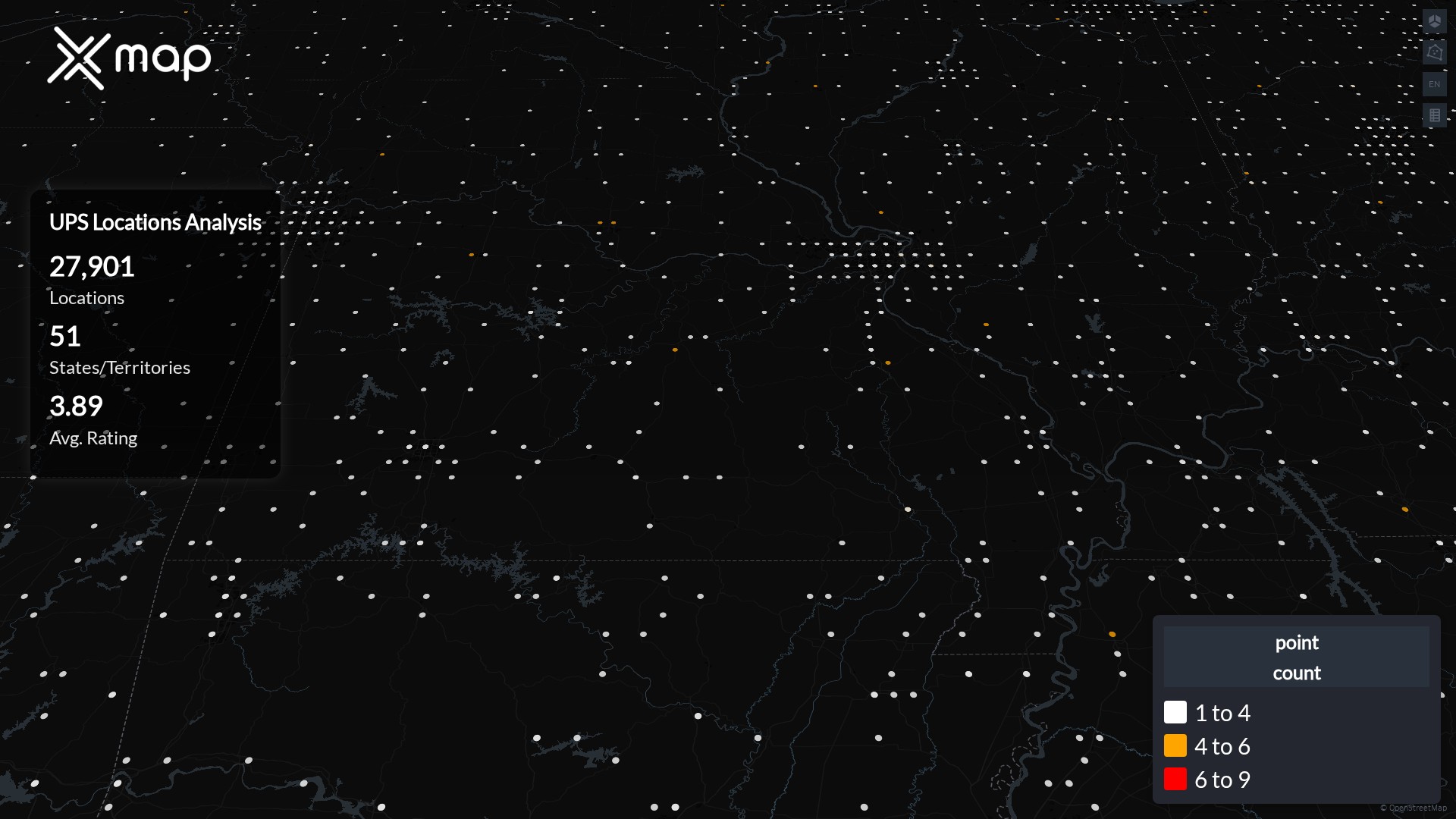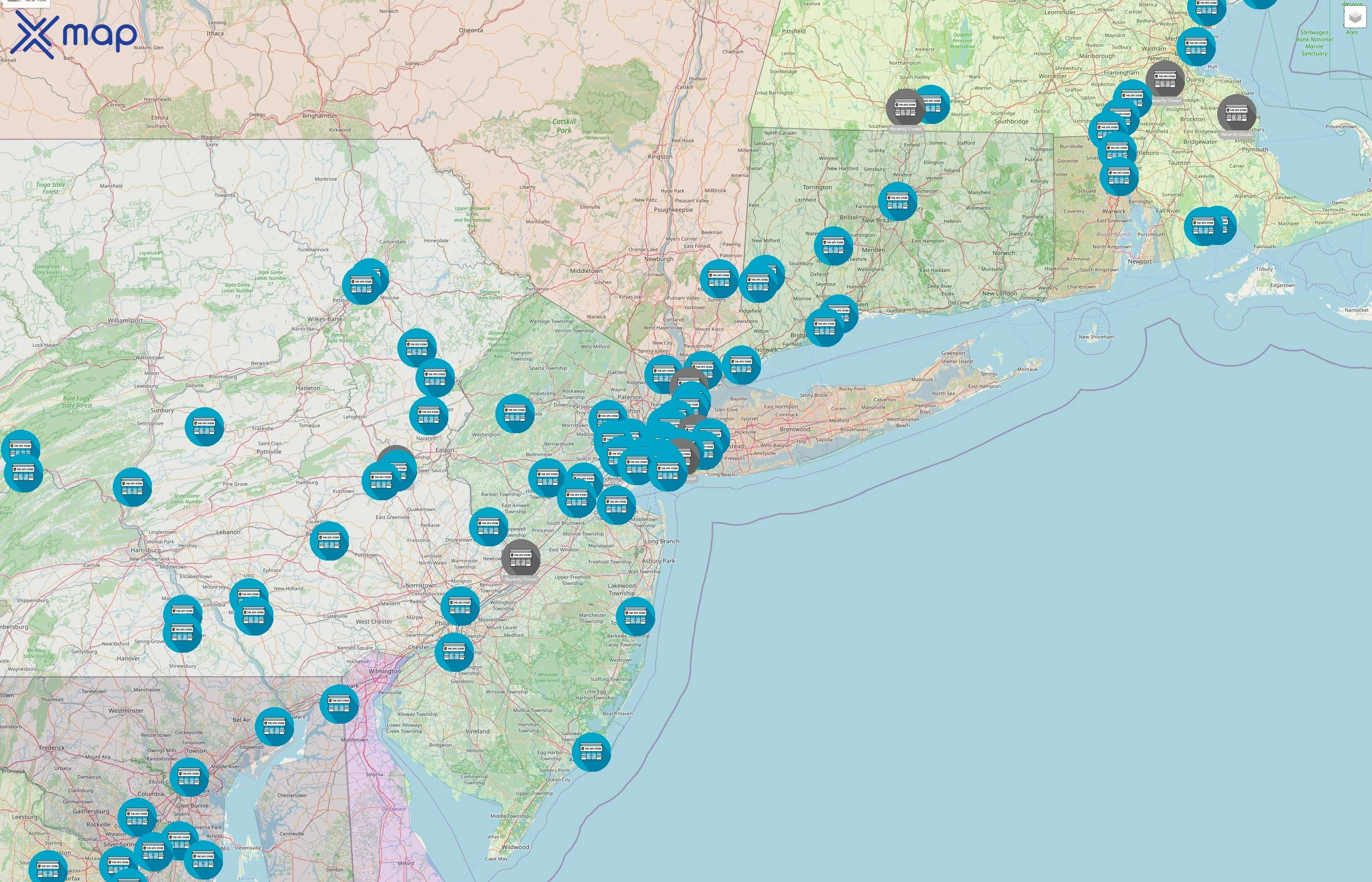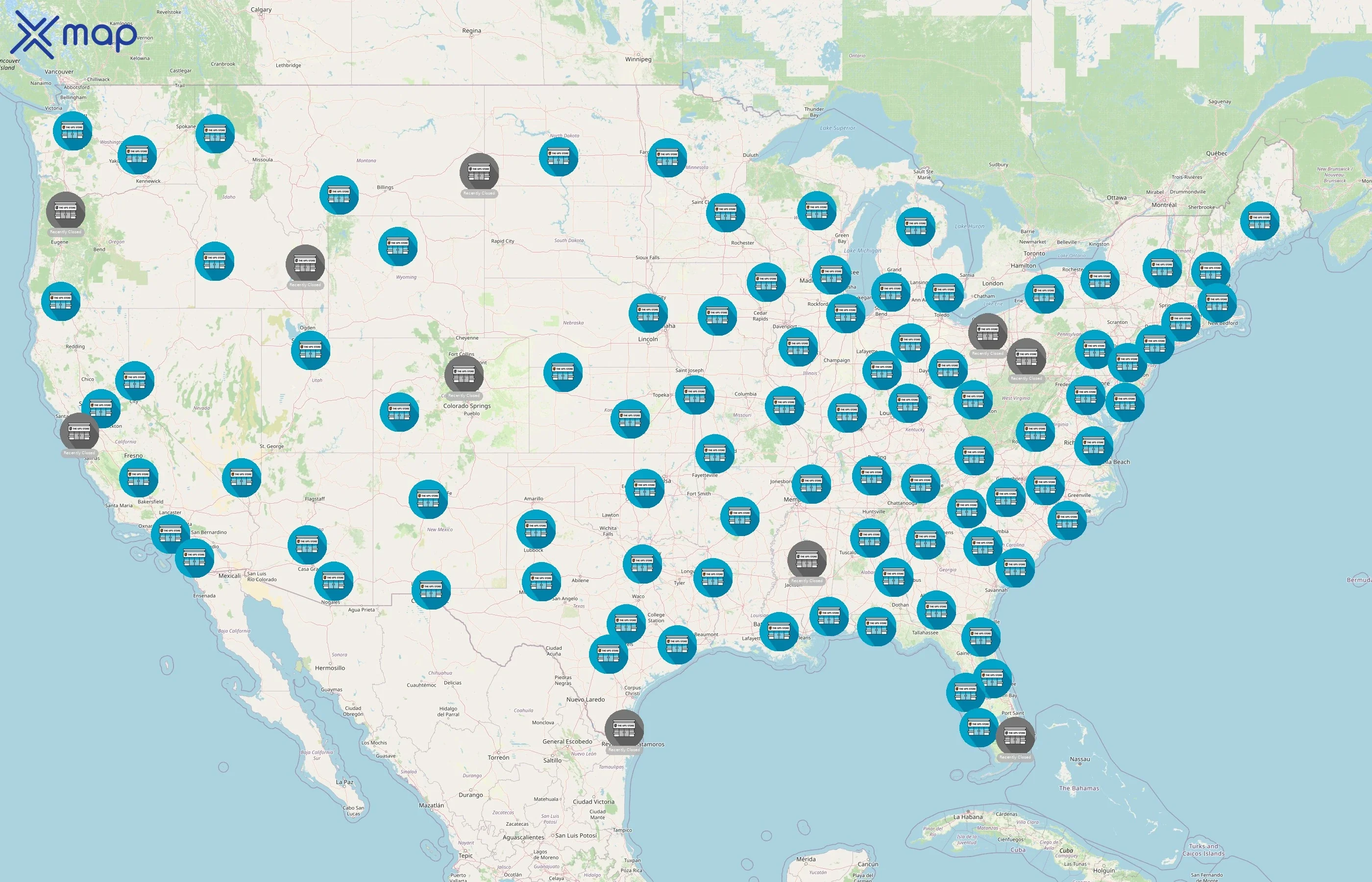米国内のUPS拠点数
2025年11月6日現在、アメリカ合衆国には27,901か所のUPSロケーションがあります。UPS の設置場所が最も多い州または準州はカリフォルニア州で、3,132 か所の拠点があり、全体の約 11.2% を占めています。

米国には UPS がいくつありますか?

27,901
22,662
27,901
27,901
7,370
アメリカ合衆国全域のUPS拠点の州別分布
UPSは、アメリカ合衆国の51の州に27,901拠点を展開しています。最大のクラスターはカリフォルニア州、フロリダ州、テキサス州にあり、上位10州には 55.5% のサイトが含まれています。ワイオミング州、ノースダコタ州、アラスカ州では対象範囲が狭くなっています。

米国内でUPSロケーションの数が最も多い上位10州
UPSは訪問者のエンゲージメントが強く、4752か所が平均トラフィックスコア(平均値:56.92)を上回り、1571か所が高訪問者数として認定されています。
UPSは米国全土で27,901拠点を運営しており、カリフォルニア州の3,132拠点(11.2%)が最も多い。上位 3 州 (カリフォルニア、フロリダ、テキサス) は全拠点の 26.9% を占め、上位 10 州は 55.5% を占めています。アクセスが最も良いのはウェストバージニア州、モンタナ州、ワイオミング州で、1 か所あたりの人口は 9,000 人未満です。逆に、アラスカ、ハワイ、ユタが最も人口密度が低く、1 か所あたりの人口は 17,900 人を超えています。
一人当たりの UPS に関するインサイト
- 各州 (ウェストバージニア州、モンタナ州、ワイオミング州) では、1 人あたりのUPSへのアクセスが最も良好です。
- カリフォルニア州、テキサス州、オハイオ州、イリノイ州、ミシガン州などの州は、多数の拠点があるにもかかわらず、一人当たりのサービスが行き届いておらず、郊外への拡張需要が見込まれています。
- いくつかの州では、人口増加とUPS密度のバランスを取っているため、競争が続くホットスポットとなっています。
米国内で最もUPSの設置場所が多い都市
場所は、ニューヨーク、ロサンゼルス、ヒューストン、シカゴ、サンディエゴなどの主要メトロに集中しています。上位 10 都市が米国のサイトの 8.2% を占めています。

ロケーション数でランク付けされた都市トップ10
UPSは、米国全土に合計27,901の拠点を構えています。所在地数で上位の都市はニューヨーク州ニューヨークで、838 か所あり、続いてカリフォルニア州ロサンゼルスで 299 か所が続きます。数が最も多い10都市を合わせると、全国のUPS拠点全体の 8.2% を占めます。
ストリートレベルのホットスポット (複数のUPSが設置されている最も混雑した通り)
街路レベルのクラスターは、同じ地域内に複数のUPS拠点がある回廊を示しており、地域での存在感と一貫性が強いことを示しています。UPSは全国で合計27901店舗を運営しています。

UPSアウトレットのポイントオブインタレストデータをダウンロード
座標、交通パターン、運用状況など、米国全土のUPS拠点の完全なデータセットをダウンロードできます。

UPSポイントオブインタレストの主な変数
UPSはアメリカ合衆国全土に27901拠点を構えています。主な変数は、全国のUPS拠点に最も影響の大きい側面を示しています。これにより、UPSがどのように運営されているかをさまざまな観点から詳しく見ることができます。
UPSロケーションごとの平均カバーエリア (州別)

米国内のUPS拠点は、国土の異なる複数の州に分散しています。テキサス州はデータセットの中で最大の州で 695,668 km²、UPS の設置場所は 2,068 か所あります。一方、オハイオ州は最小で 116,098 km²、975 か所あります。カリフォルニア州は423,965km²あり、UPSの設置場所の数が最も多く、3,132か所です。その他の注目すべき州には、2318 か所の拠点を持つフロリダ州、815 か所の拠点がある250,486 km²のミシガン州があります。
UPS拠点の事業状況 (営業中と閉店)

米国では、UPSはカリフォルニアで最もオープンしている店舗数が2,657店舗あり、合計3,132店舗の84.8%に相当します。フロリダ州に続いてオープン店舗数が 1,641 店舗あり、合計 2,318 店舗の 70.8% を占めています。テキサス州とニューヨーク州はそれぞれ1,600店舗と1,374店舗をオープンしており、オープン率は 77.4% と 74.6% です。ペンシルベニア州は上場州の中で 68.3% と最も低いオープン率を示しており、合計1,197店舗のうち817店舗がオープンしています。
UPSロケーションの交通データ (州別)
このビューでは、各州のUPS拠点付近のアクティビティを比較しています。27,901 か所のサイトで観測されたトラフィックスコアを使用して、最も混雑する市場、平均以上のロケーションのシェアが高い州、およびアクティビティが比較的少ない地域が強調表示されます。パフォーマンスのベンチマークや現場業務の優先順位付け、事業拡大や最適化の機会の特定に活用してください。

上位 10 州のうち、混雑している UPS ロケーションはどれですか?
UPSはカリフォルニアで最も利用者の多い拠点数を誇り、合計3,132拠点のうち222拠点(7.1%)を占めています。テキサス州は 9.6% と最も混雑している拠点の割合が最も高く、2,068 か所のうち 198 か所です。また、オハイオ州では、全体の 975 か所のうち 96 か所の混雑率が 9.8% と非常に高くなっています。フロリダ州とノースカロライナ州の混雑地域のシェアは、それぞれ 9.3% と 9.2% です。
UPSロケーションのカスタマーレビューと評価
このセクションでは、UPSに対するお客様の感想をまとめています。27,901か所の評価とレビューの合計を使用して、スコアが一貫して高く、フィードバックの量が最も多い場所に焦点を当てます。星による平均評価は質の高さを反映し、レビュー総数はネットワーク全体でのエンゲージメントとリーチを示します。

平均評価
UPSの平均評価はノースカロライナ州で4.1と最も高く、フロリダ州、ミシガン州、オハイオ州、ペンシルベニア州がそれに続き、それぞれの平均評価は4.0です。レビュー件数はフロリダ州が120,638件でトップで、カリフォルニア州の110,295件、テキサス州の105,386件を上回っています。ニューヨークとジョージアもそれぞれ 60,984 件と 48,752 件のレビューで大きく貢献しています。
レビュー数
UPSはノースカロライナ州で4.1と最も高い平均評価を受け、続いてフロリダ州、ミシガン州、オハイオ州、ペンシルベニア州が続き、それぞれの平均評価は4.0でした。フロリダ州のレビュー総数は120,638件でトップで、カリフォルニア州 (110,295件) とテキサス州 (105,386件) を上回りました。ニューヨーク州とジョージア州は、レビュー数で上位5州を締めくくりました。
確認済みの連絡先情報が記載されたUPSの所在地

連絡先情報
UPSは、米国内の全リスト州で電話を完全にカバーし、各州で 100% の保証を実現しました。電話対応地域の数が最も多かったのはカリフォルニア州の3,132か所で、フロリダ州が2,318か所、テキサス州が2,068か所と続きました。これらの州の中で最も数が少なかったのはミシガン州で、電話がカバーされている場所は 815 か所でした。
UPS ポイントオブインタレストデータのユースケース
市場分析
UPS POIデータにより、設置面積と需要を明確に測定できます。アナリストは、州や都市を場所の数でランク付けし、対象地域を一人当たりで比較し、トラフィック・スコアや調査量を活用して、業績の高い市場やサービスの行き届いていない地域を特定できます。その結果、飽和状態、成長機会、業績外れ値を客観的に把握できます。
サイト選択
ネットワーク計画では、このデータは、立地密度、場所ごとの人口、および近隣の交通量を使用して候補商圏をスコアリングするのに役立ちます。チームは、店舗から最も近い距離から競合リスクを評価したり、主要な通路に沿って空白を浮き彫りにしたり、観察された活動が最も活発な小売店街、キャンパス、交通機関に近い場所に優先順位を付けたりできます。
都市計画
計画担当者は、クラスターとサービスギャップをマッピングして、近隣レベルでの商業アクセスを把握できます。一人当たりの調査ではアクセスが制限されているコミュニティが強調され、開館や閉鎖の変化は活動の変化を示唆しています。これらの洞察は、回廊の活性化、街並みと交通計画、データ主導のゾーニングの決定に役立ちます。
このxMapのPOIデータは企業にどのように役立ちますか?
- 精度と精度: xMap データは精度の高いデータを提供するため、欠陥のある情報に基づいて誤った判断を下す可能性が最小限に抑えられます。
- 完全なデータ: xMapを使用すると、企業は包括的で完全なデータにアクセスできるため、知識のギャップを効果的に埋め、意思決定のための包括的なビューを提供できます。
- 最新情報: xMapは、提供されたデータが定期的に更新されることを保証します。これにより、企業は現在の傾向や状況に合わせて、動的でタイムリーな意思決定を行うことができます。
- スケーラビリティ: xMap データは、さまざまな事業規模や要件に対応するインサイトを提供することで、事業を効率的に拡大することができます。
- 分析力: xMapデータの分析を活用することで、パターンや傾向を特定できるため、企業の戦略的計画と予測が強化されます。


